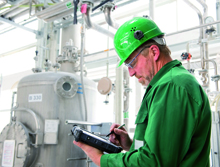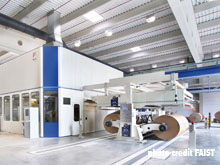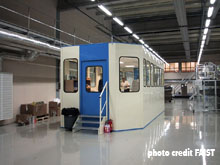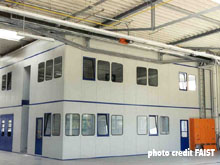Noise at workplaces and in work premises is a problem:
- for the working conditions of employees, when it is the cause of fatigue, stress, difficulties in communicating orally (e.g. with colleagues, superiors, subordinates) or by telephone (e.g. with other employees of the considered company, with customers, suppliers, personnel of the Administration), or when it causes difficulty in concentrating on their tasks
- for the health of employees, when the level of ambient noise opposes the proper perception of warning signals (horns, sirens) or when the combination of exposure to high sound levels and the duration of this exposure are likely to cause hearing loss
Excessive noise levels have harmful consequences not only for the workers, but also for the companies that employ them (deterioration of the working ambiance, loss of quality, absenteeism, difficulties in recruiting, and in some cases: cost of recognized occupational deafness).
To fight against such nuisances, ITS carries out the measurement and study of noise at workplaces and in work premises, and proposes solutions, for the improvement of the usual performance indicators which are, in such cases, the sound pressure level[1], and (in enclosed and covered spaces) reverberation time (duration)[2] and spatial noise decay rate[3] against which different reference documents can be considered, for comparison purposes:
- those which, while not mandatory, provide - based on consensus - recommendations for different workspaces[4],[5],[6]
- those which constitute the law (that no one can ignore)[7],[8]
- those resulting from the application of soundproofing contracts, a fortiori when they provide for an obligation of result subject to a guarantee
These different activities, practiced for a long time by the human resources of ITS, are regularly assessed in accordance with the requirements of the ISO 9001 standard (relating to quality management systems).
They concern places and work premises of all kinds:
- production, processing, assembly, packaging workshops and halls (before or after installation of machines, lines, equipment and production devices) for industry (rubber, plastics, metallurgy, textiles, clothing, food processing, IT, electronics, electrical equipment and machinery, construction - transport: automotive, heavy goods vehicles, aeronautics, naval, rail, prefabrication for the building sector -, wood, paper and cardboard, furniture, chemicals, pharmaceuticals, extraction of raw materials and energy sector) such as for crafts
- individual or collective offices e.g. open plan offices, open spaces before or after their fitting out i.e. including the spaces to be fitted out (industry, public bodies and administrations)
- technical rooms
With regard to sound sources, measurement and study of noise at workplaces and in work premises as proposed by ITS relate to those whose operation is permanent (possibly with modulations of sound emissions according to the regime considered) e.g. linked to production, but also to related equipment such as for Heating, Ventilation, Air Conditioning (HVAC), dusting or intermittent networks (of different types), whether they are located in the space considered for the measurements or in a contiguous space (indoor or outdoor).
Measurement of noise at workplaces and in the work premises
ITS carries out noise measurement at workplaces and in work premises in different contexts, to verify the compliance of one or more of the acoustic performance indicators with one or more reference values based as indicated above:
- in the context of a diagnosis, if necessary: prior to the definition of an action plan for the fight against noise (when you are looking for your way, it is good to know where you are)
- after the implementation of solutions to reduce noise pollution or improve hearing comfort, for the purpose of evaluating their effectiveness
Such acoustic measurements are carried out on site by a human resource duly qualified in physical measurements (specialized in instrumental techniques) with long experience in sound metrology, with measurement means subject to periodical verification and calibration (ITS acoustic measurement means namely include sound level meters, calibrators, noise generators, data processing software).
|
Sound pressure level measurement often base noise study at workplaces and in work premises |
(which may be considered as being the first step in a noise abatement study) the determination of sound levels at specified locations (e.g. at workstations), the preparation of noise maps, the evaluation of the reverberation time, the calculation of the decrease in sound level by doubling the distance to the source (depending on the context) and a conclusion as to the result of the comparison of the measurement results with reference values - as well as, if necessary, the formulation of avenues for progress - all presented in a complete, clear and detailed report - is what can be expected from an ITS intervention for acoustic measurements at workplaces and in work premises.
Study of noise at workplaces and in work premises, solutions
When acoustic measurements (carried out by ITS or by others) have highlighted the usefulness (sometimes: the obligation made by a regulation or the applicability of a technical specification) to improve a given situation (to treat a non-conformity, or to improve the comfort of workers (e.g. inside a room) with respect to the problem that noise commonly constitutes, and also when on-site measurements are not possible (e.g. in pre-project phase), ITS carries out a noise study at workplaces and in work premises, and defines solutions.
Such an engineering mission is carried out at ITS by a human resource with a degree in building physics, specialized in sound transmission and propagation calculations, with solid knowledge of construction (materials and systems), and for whom the confrontation with the problems of noise and reverberation of premises is a long-standing practice, within the framework of projects of all levels of technicality.
Depending on the context, the study of noise at workplaces and in work premises, and the development of solutions involve:
- the definition of objectives in terms of acoustics - as mentioned above: sound pressure level [1], reverberation time[2], spatial decay rate[3] - and the drafting of a measurement protocol allowing their verification at the end of the implementation of solutions
- calculations, with, where appropriate, modeling of the considered space and simulations of acoustic performance (of structures), sound propagation and absorption (in the case of silencers, the aeraulic performance i.e. aerodynamics can be determined); ITS has many simulation and predictive calculation means for acoustics)
- the selection of construction products and systems, with performance indicators (variable according to frequency) such as the sound absorption coefficient (in % i.e. from 0 to 1 except when measured in a reverberation room, the Sabine factor can be higher), the sound reduction index (in dB) and - in the case of silencers: the insertion loss (in dB) –
- drafting of technical specifications for devices to reduce noise or reverberation in confined spaces
When appropriate, different scenarios are considered for the study of noise at workplaces and in work premises and the definition of solutions, which may differ according to the advantages and disadvantages of the related soundproofing solutions (in particular):
- acoustic performance
- impact on aspects of working conditions other than acoustics (e.g. ergonomics, maintenance)
- practicability of the implementation
- durability
- cost
The list of criteria that can be taken into account when carrying out the study of noise at workplaces and in work premises, and defining solutions by ITS is not always limited to what is mentioned above, depending on the specifics of each project (e.g. impact resistance for anything that can - such as: a noise barrier, enclosure or cabin wall - obstruct the movement of machinery or the handling of sometimes bulky parts must subject to specific consideration in a boiler workshop, the cleanability of sound-absorbing linings must be considered as a priority in a food-processing room) and is of course adapted to the needs and preferences of each Customer.
The human resource of ITS attach great importance to the development of personalized solutions, optimized in terms of consideration of the different aspects (technical, logistical, economic); experience (like that of ITS in all sectors of activity) counts when it comes to making the best choices in terms of solutions for the control of noise or of reverberation of premises.
What can be expected from ITS for the study of noise at workplaces and in the work premises, in terms of solutions is possibly:
- reduction of noise at the source, by means of a construction that completely envelops the noisy hardware. Depending on the context, it may be a soundproofing casing for a machine, an acoustic enclosure for a production line or equipment, or even a structure similar to a building (with walls and a roof). In an industrial environment, metal constructions are often preferred, involving:
- sound insulation panels
- acoustic doorsets
- acoustic glazed frames
- ventilation silencers for air renewal and for the evacuation of dissipated thermal power
|
|
An enclosure made with soundproofing panels, with acoustic door-sets and glazed frames, and with silencers for ventilation is an effective mean of reducing machine noise at source in a workplace. |
|
Vent silencers for pressurized gas, exhaust silencers for internal combustion engines complete the ordinary panoply of solutions recommended by ITS in terms of noise reduction at source in many industrial sectors, while more specifically (in the electricity production sector), it is possible to use silencers for combustion turbines (gas turbines) (for intake or for exhaust)
- the reduction of noise propagation for the protection of specified locations, by means of acoustic screens (i.e. noise barriers), which, in terms of construction for industrial applications, differ from what has been said above about enclosures by the absence of a roof; in the case of collective offices (i.e. open spaces) - but also in the case of company restaurants (i.e. canteens allowing employees to have lunch at their place of work) - the acoustic screens can take the form of dividers
- the limitation of reverberation i.e. of the reflection of sound waves on hard surfaces which are usually floors, and (for the major part of the frequency spectrum) glazing or other construction elements which do not have performance in terms of sound absorption, involving (in addition to the surfaces of the screens and screens mentioned above, if they are like those of the soundproofing equipment marketed by ITS)
- suspended baffles and suspended ceiling tiles for the soundproofing of industrial work premises
- sound absorbing wall linings for industrial work premises
- the protection of personnel by means of soundproof cabins, which differ from enclosures in that the positions of noise sources and workers are reversed. As a result, the constructions of such soundproof workshop offices are similar to those of enclosures (see above), with of course the adaptations allowing the necessary habitability and the required level of comfort.
|
|
|
A soundproof office offers good working conditions in a workshop, especially for tasks requiring protection from excessive noise. |
The study of noise at workplaces and in the work premises, and the definition of solutions by ITS are an opportunity to review, use and combine (adapting them to the requirements of each project) the (proven) principles of soundproofing mentioned above to retain the best for the improvement of the considered acoustic situation, which may be the subject of a guarantee of results after work.
Depending on the context, the measurement and study of noise at workplaces and in work premises and the definition of solutions can be carried out for the benefit of an Original Equipment Manufacturer (OEM), of an installer (of a noisy hardware), or of an end user in all activity sectors.
Choice soundscapes, everywhere. This is the slogan of ITS.
Spread the word !
[1] twenty times the decimal logarithm of the ratio of sound pressure (measured with a sound level meter) to the value of the reference sound pressure (2.10-5 Pa); the difference in sound pressure level between two rooms is generally referred to as sound reduction index
[2] time, in seconds, required for the existing sound level in a room to decrease by 60 dB when the noise source is instantly interrupted
[3] slope in decibels of the spatial sound decay curve in a given distance range, when the distance to the source doubles
[4] standard ISO 11690-1 Acoustics - Acoustics — Recommended practice for the design of low-noise workplaces containing machinery — Part 1: Noise control strategies
[5] standard NF S 31-080 Acoustics - Offices and associated areas - Acoustic performance levels and criteria by type of area
[6] standard NF S31-199 Acoustics - Acoustic performance of open office spaces
[7] European directive 2003/10/EC concerning the minimum health and safety requirements relating to the exposure of workers to the risks due to physical agents (noise) stipulating:
- for the daily noise exposure level L EX, 8 hours: 80 dB(A) and 85 dB(A) are the thresholds, respectively lower and upper, triggering the action; 87 dB(A) is the authorized limit value
- for the peak sound pressure ρpeak: 112 Pa i.e. 135 dB(C) and 140 Pa i.e. 137 dB(C) are the thresholds, respectively lower and upper, triggering the action; 200 Pa i.e. 140 dB(C) is the permitted limit value
[8] (in France) Order of 30 August 1990 issued for the application of article R. 235-11 of the labor code and relating to the reverberation control of work premises (regarding the decrease in sound level by doubling the distance from the source):
- considered in the empty room (no machine or production device), the authorized limit varies from 2 dB(A) to 4 dB(A) depending on the floor area of the room (the boundary values being 210 m2 and 4600 m2)
- considered after installation of machines and production devices, the authorized limit varies from 3 dB(A) to 4 dB(A) depending on the floor area of the room (the boundary values being 210 m2 and 1000 m2)

 enclosure for a corrugator
enclosure for a corrugator  soundproofed control room
soundproofed control room soundproofed workshop offices on 2 floors
soundproofed workshop offices on 2 floors